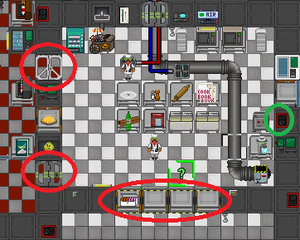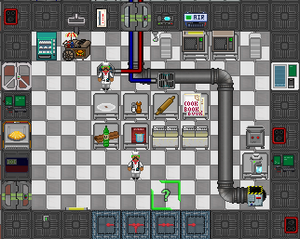Mapping Room Structure: Difference between revisions
(added, will update more at some later time) |
m (Fixed the spelling on some words.) |
||
| (2 intermediate revisions by one other user not shown) | |||
| Line 1: | Line 1: | ||
This guide will provide you will image references to make sure the room structures on your map are appropriate. | This guide will provide you will image references to make sure the room structures on your map are appropriate. | ||
===Fire Alarms and Fire Doors=== | ===Fire Alarms and Fire Doors=== | ||
[[File:structure1.png|thumb|Fire alarms and fire doors.]]Make sure to put these inside of the boundary of the area, so there is a lock down. Any spot that gets hot as a normal function should not have a fire alarm right next to the heat source (toxin mix chamber). Make sure there is a fully sealed area | [[File:structure1.png|thumb|Fire alarms and fire doors.]]Make sure to put these inside of the boundary of the area, so there is a lock down. Any spot that gets hot as a normal function should not have a fire alarm right next to the heat source (toxin mix chamber). Make sure there is a fully sealed area that can't be opened by normal civilians. | ||
In the image on the right, the fire doors are circled in red and the fire alarms are circled in green. The fire doors are on all airlocks going into the room. The fire alarm is in a place that can be easily accessed from inside the room, and there is only 1 as the room is small. | |||
Recently updated is the type of firelocks we use on Yogstation. We now use the /border_only firelocks, placed under almost all airlocks and windows. When placing these, make sure their direction is the correct way - you can use the current maps as an example. | |||
[[File:Structure2.png|thumb|left|Weak Points.]] | [[File:Structure2.png|thumb|left|Weak Points.]] | ||
===Room Security=== | ===Room Security=== | ||
Judge how high security the room will be. If it is high security, reinforced walls and electrified | Judge how high security the room will be. If it is high security, reinforced walls and electrified grille windows may be in order. Areas that do not need a lot of security can use basic walls and windows to your liking (though normal glass windows break very easy). Each room should have one place that's weaker than the rest (like a back door, side entrance, or a window), just because the main entrance might be out of commission (and realistically, for traitors to break into). | ||
The image on the left shows a bad example of a high security room. That room is the kitchen, which has no reason to be high security as it is not a high-risk area (such as the brig or engineering). Take note however of the reinforced walls and the electrified windows, as you want to use these in rooms that require extra security. A room is only as secure as its necessity. Public rooms should not have many security functions (other than a fire alarm), but private work space must be more secure (based on job). The bartenders do not need reinforced walls around their storage, but engineers do. | The image on the left shows a bad example of a high security room. That room is the kitchen, which has no reason to be high security as it is not a high-risk area (such as the brig or engineering). Take note however of the reinforced walls and the electrified windows, as you want to use these in rooms that require extra security. A room is only as secure as its necessity. Public rooms should not have many security functions (other than a fire alarm), but private work space must be more secure (based on job). The bartenders do not need reinforced walls around their storage, but engineers do. | ||
The highest security rooms should utilize the highest security measures. The lowest security rooms should utilize the cheapest security measures. | The highest security rooms should utilize the highest security measures. The lowest security rooms should utilize the cheapest security measures. | ||
===Item and Machinery Distribution=== | ===Item and Machinery Distribution=== | ||
Be smart about what will go in an area. Keep a fine balance between the size of the room and amount of equipment. Boxstation is a good map to look at for item distribution, as it doesn't have needlessly large spaces. Large rooms may require multiple APCs (hallways and engineering for example) to prevent power outages early in-game, but try to only use one if possible. Second, make sure to place equipment that make sense for the area (security computer in a security area/medical vendor in a medical area). | Be smart about what will go in an area. Keep a fine balance between the size of the room and amount of equipment. Boxstation is a good map to look at for item distribution, as it doesn't have needlessly large spaces. Large rooms may require multiple APCs (hallways and engineering for example) to prevent power outages early in-game, but try to only use one if possible. Second, make sure to place equipment that make sense for the area (security computer in a security area/medical vendor in a medical area). | ||
Linking to the room weak points, the harder the room is to enter the more goodies or sensitive equipment there is inside. Make sure to keep this in mind - don't make an empty room that's covered in blast doors, electrified | Linking to the room weak points, the harder the room is to enter the more goodies or sensitive equipment there is inside. Make sure to keep this in mind - don't make an empty room that's covered in blast doors, electrified grilles, reinforced walls, and captain level doors. Take a look at the difference in security and equipment in the armory and then in the cargo office. | ||
===Windows to Space=== | |||
All windows that are next to a space tile need to be /obj/effect/spawner/structure/window/reinforced/shutter. There are alternative versions for other window types. | |||
[[Category:Guides]] [[Category:Game Resources]] | [[Category:Guides]] [[Category:Game Resources]] | ||
{{Contribution guides}} | {{Contribution guides}} | ||
Latest revision as of 07:55, 15 November 2021
This guide will provide you will image references to make sure the room structures on your map are appropriate.
Fire Alarms and Fire Doors
Make sure to put these inside of the boundary of the area, so there is a lock down. Any spot that gets hot as a normal function should not have a fire alarm right next to the heat source (toxin mix chamber). Make sure there is a fully sealed area that can't be opened by normal civilians.
In the image on the right, the fire doors are circled in red and the fire alarms are circled in green. The fire doors are on all airlocks going into the room. The fire alarm is in a place that can be easily accessed from inside the room, and there is only 1 as the room is small.
Recently updated is the type of firelocks we use on Yogstation. We now use the /border_only firelocks, placed under almost all airlocks and windows. When placing these, make sure their direction is the correct way - you can use the current maps as an example.
Room Security
Judge how high security the room will be. If it is high security, reinforced walls and electrified grille windows may be in order. Areas that do not need a lot of security can use basic walls and windows to your liking (though normal glass windows break very easy). Each room should have one place that's weaker than the rest (like a back door, side entrance, or a window), just because the main entrance might be out of commission (and realistically, for traitors to break into).
The image on the left shows a bad example of a high security room. That room is the kitchen, which has no reason to be high security as it is not a high-risk area (such as the brig or engineering). Take note however of the reinforced walls and the electrified windows, as you want to use these in rooms that require extra security. A room is only as secure as its necessity. Public rooms should not have many security functions (other than a fire alarm), but private work space must be more secure (based on job). The bartenders do not need reinforced walls around their storage, but engineers do.
The highest security rooms should utilize the highest security measures. The lowest security rooms should utilize the cheapest security measures.
Item and Machinery Distribution
Be smart about what will go in an area. Keep a fine balance between the size of the room and amount of equipment. Boxstation is a good map to look at for item distribution, as it doesn't have needlessly large spaces. Large rooms may require multiple APCs (hallways and engineering for example) to prevent power outages early in-game, but try to only use one if possible. Second, make sure to place equipment that make sense for the area (security computer in a security area/medical vendor in a medical area).
Linking to the room weak points, the harder the room is to enter the more goodies or sensitive equipment there is inside. Make sure to keep this in mind - don't make an empty room that's covered in blast doors, electrified grilles, reinforced walls, and captain level doors. Take a look at the difference in security and equipment in the armory and then in the cargo office.
Windows to Space
All windows that are next to a space tile need to be /obj/effect/spawner/structure/window/reinforced/shutter. There are alternative versions for other window types.
Contribution guides
| |
| General | Hosting a server, Setting up git, Guide to GitKraken, Downloading the source code, Guide to contributing to the game, Reporting issues, Game resources category, Guide to changelogs |
| Database (MySQL) | Setting up the database, MySQL |
| Coding | Understanding SS13 code, SS13 for experienced programmers, Text Formatting |
| Mapping | Guide to mapping, Room Structure, Map merger |
| Spriting | Guide to spriting |
| Wiki | Guide to contributing to the wiki, Wikicode, Styleguide |

